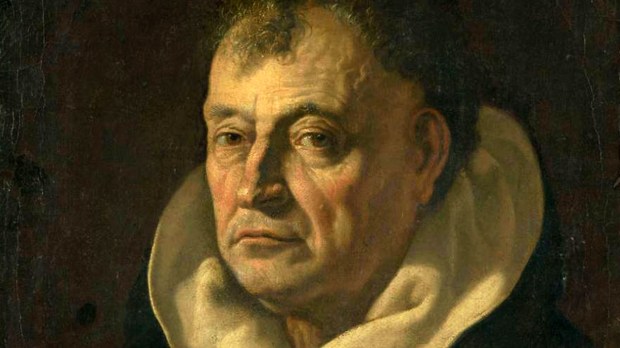Described as “one of the most important philosophers of the late-Renaissance,” he has remained a rather obscure figure, perhaps because most of the existing information about him appears in the Italian language.
Tommaso Campanella was born as Giovanni Domenico Campanella in Calabria, the southernmost region of mainland Italy. Coming from a disadvantaged background, he emerged as something of a “child prodigy.” At age 14, he took the name “Tommaso” (in honor of Thomas Aquinas) when he entered the Dominican order.
He began receiving formal instruction in philosophy and theology. Though plenty studious, he was not always an obedient scholar. As he entered adulthood, his questioning mind and bold disposition led him to explore and, in some cases, broadcast his support for controversial works and viewpoints (such as the teachings of Bernardino Telesio, who contradicted the more-established philosophy of Aristotle).
By 1594, Campanella had strayed far enough from Dominican orthodoxy that he fell under the piercing scrutiny of the Inquisition. It could have been much worse: The Inquisition sentenced him to about two years of confinement. Upon his release, he was ordered to go back to Calabria.
Returning to his home region, Campanella proceeded to find a whole new world of trouble. Playing a major role in a conspiracy against the ruling Spanish government, he eventually faced charges of heresy and rebellion.
Narrowly avoiding a death penalty, he instead received a sentence of life imprisonment. Many would have preferred the first option, especially when considering that part of his punishment regimen consisted of sessions on the “rack” – in which the victim, with arms bound behind the back, is tied to a pulley, then elevated, then dropped. This procedure forces the shoulders to dislocate violently: The word “torture” is no exaggeration here. He was also subjected to the “vigil,” in which captors inflict extreme sleep deprivation on prisoners.
Under these horrendous conditions, Campanella wrote prolifically – maintaining correspondence with his era’s leading thinkers and authoring such titles as Atheismus triumphatus (Atheism Conquered) and The Monarchy of Spain. He also produced his most famous volume, The City of the Sun, about a utopian society where the government is theocratic, all property is communal, and all occupations command equal respect (the only sources of disdain are idleness and pretensions to nobility).
Campanella was befriended by a German scholar, Caspar Schoppe, who visited him in prison and helped circulate his written works, such as The City of the Sun, which appeared in the Latin language at a Frankfurt printing house in 1623.
By that time, Campanella, still imprisoned, was busy giving his written support to Galileo Galilei (the two had personally met as young men in 1592), who was mired in controversy for supporting Copernican heliocentrism.
Upon spending 27 years in captivity, Campanella finally caught a break: Pope Urban VIII, appealing directly to the Spanish King Philip IV, was able to secure his freedom.
Campanella left prison on May 15, 1626. At that point, he was age 57 and had spent the vast majority of his adulthood as a mistreated prisoner. He later resided in Rome, where he served as the papal adviser on astrological matters. This position was dissolved, however, when Urban VIII grew concerned that others in the Church hierarchy might view his star-alignment consultations with Campanella as heretical, superstitious pursuits.
In 1634, a new political conspiracy in Campanella’s turbulent home region risked returning him to prison for the rest of his life. However, through the assistance of a friendly local cardinal and French ambassador, he was able to successfully flee to France.
There he found rather comfortable circumstances – Cardinal Richelieu gave him political protection, and King Louis XIII gave him a considerable allowance. To show his gratitude, Campanella wrote a poem commemorating the birth of Louis XIV, the future “Sun King.” (Campanella was a rather active composer of sonnets, and centuries later the British poet J.A. Symonds would publish a translated volume of his poetical works.)
Having spent his final years in the Dominican monastery on Saint-Honoré in Paris, Campanella died on May 21, 1639, at age 70.
Never the easiest man to get along with, Campanella had a temperament which “led him into the expression of views offensive to many of the older and newer schools alike.” But his resilience was seemingly indomitable. Amid decades of incarceration and repeated torture, he wrote things that far outlasted anything his tormentors could inflict.



